Transforming education isn’t just a lofty ideal — it’s our imperative.
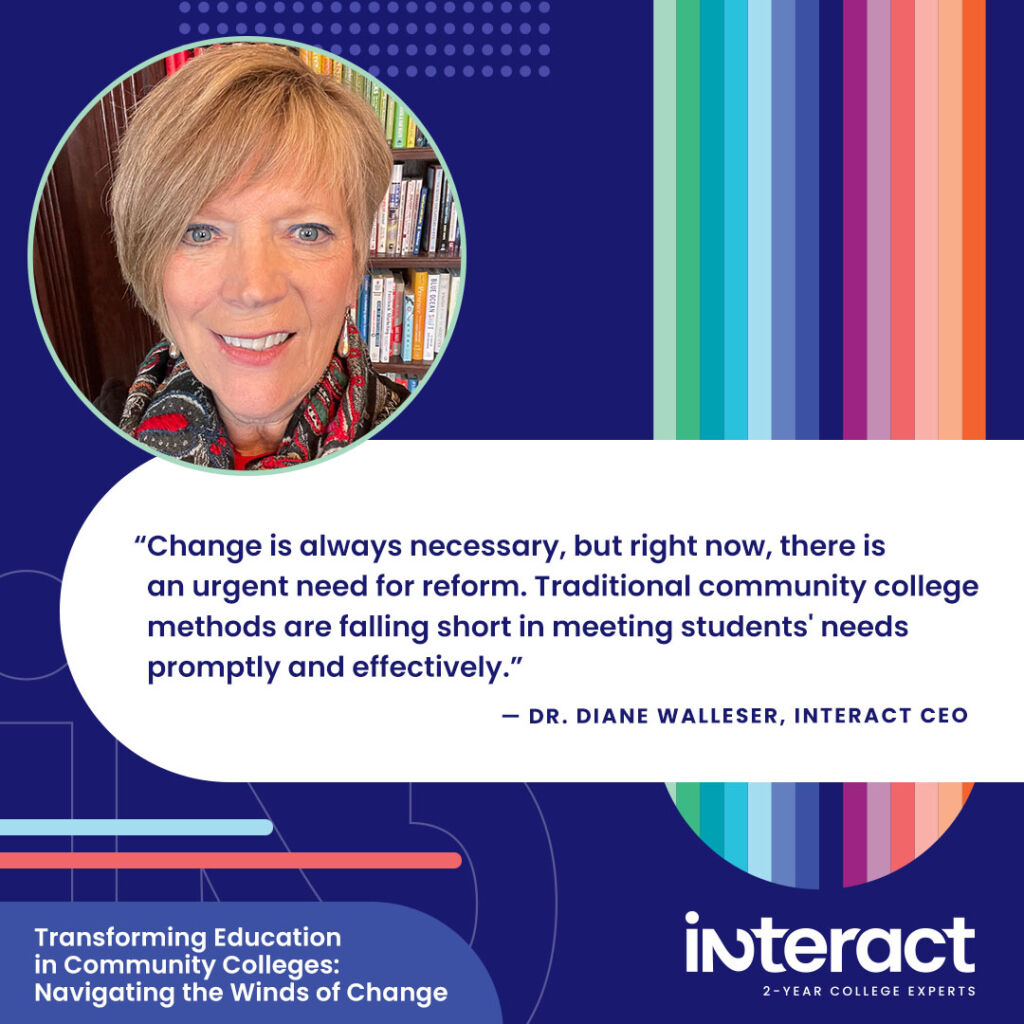
“Change is always necessary, but right now, there is an urgent need for reform,” says our CEO, Dr. Diane Walleser. “Traditional community college methods are falling short in meeting students’ needs promptly and effectively.”
The winds of change are blowing — but how agile, willing, and adaptable is your college in transforming education?
From Valleys to Peaks: Seismic Shifts in Leadership and Enrollment
All two- and four-year institutions are feeling the crunch, from dwindling enrollment at the ground level to dramatic shifts at the top. Over the last few years, the average tenure of college presidents has shrunk from 10 to just 3.7 years, according to The Changing Higher Ed Podcast. Meanwhile, a recent survey cited by the Chronicle of Higher Education reveals that one in four presidents plans to step down within the next year or two.
“We’ve talked a lot about COVID creating problems in enrollment,” says Walleser. “However, this demographic downturn has been happening for 10 years, and people have ignored it.”
Keep reading for our CEO’s insight on why it’s time to embrace change and how to lead it confidently.
Sweeping Change Management: A Guide to Transforming Education
When the winds of change are blowing at your institution, the way to adapt is change management. Change management is about building a framework to help administrators, faculty, and staff navigate the future confidently and gracefully.
There are a lot of methods and systems for change management out there. But generally, you can boil those steps down into five actions:
- Understand the need for change and prepare.
- Create a vision and a plan for change, using good communication along the way to gain buy-in.
- Establish your goals and implement the changes.
- Make the new changes a part of the college culture, training, and processes.
- Take stock of the changes you’ve made and measure your progress.
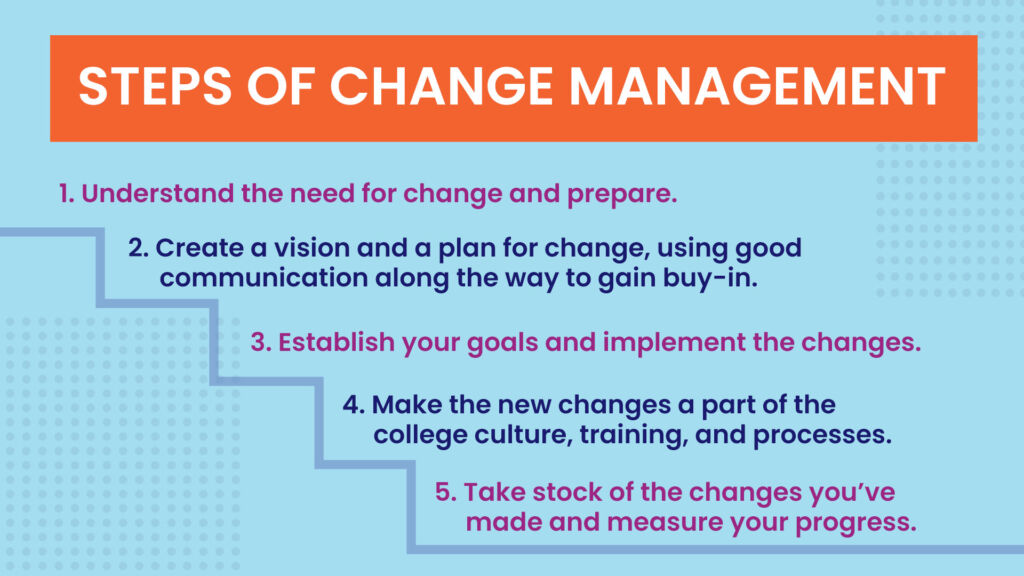
With a process and a plan in place, change doesn’t have to be overwhelming. Why, then, do so many colleges struggle with implementing change?
What’s the Biggest Challenge to the Change Management Process?
Interact has worked with colleges nationwide on change management, and many face similar obstacles.
“The primary obstacle to instigating meaningful change lies in the lack of buy-in among teams and departments,” explains Walleser. “This disconnect and discord frequently originate from inadequate communication,” adds our CEO. “At times, individuals may lack comprehensive information, leading to inaccurate perceptions. Alternatively, even with access to data and valuable insights, some may feel excluded from the decision-making process.”
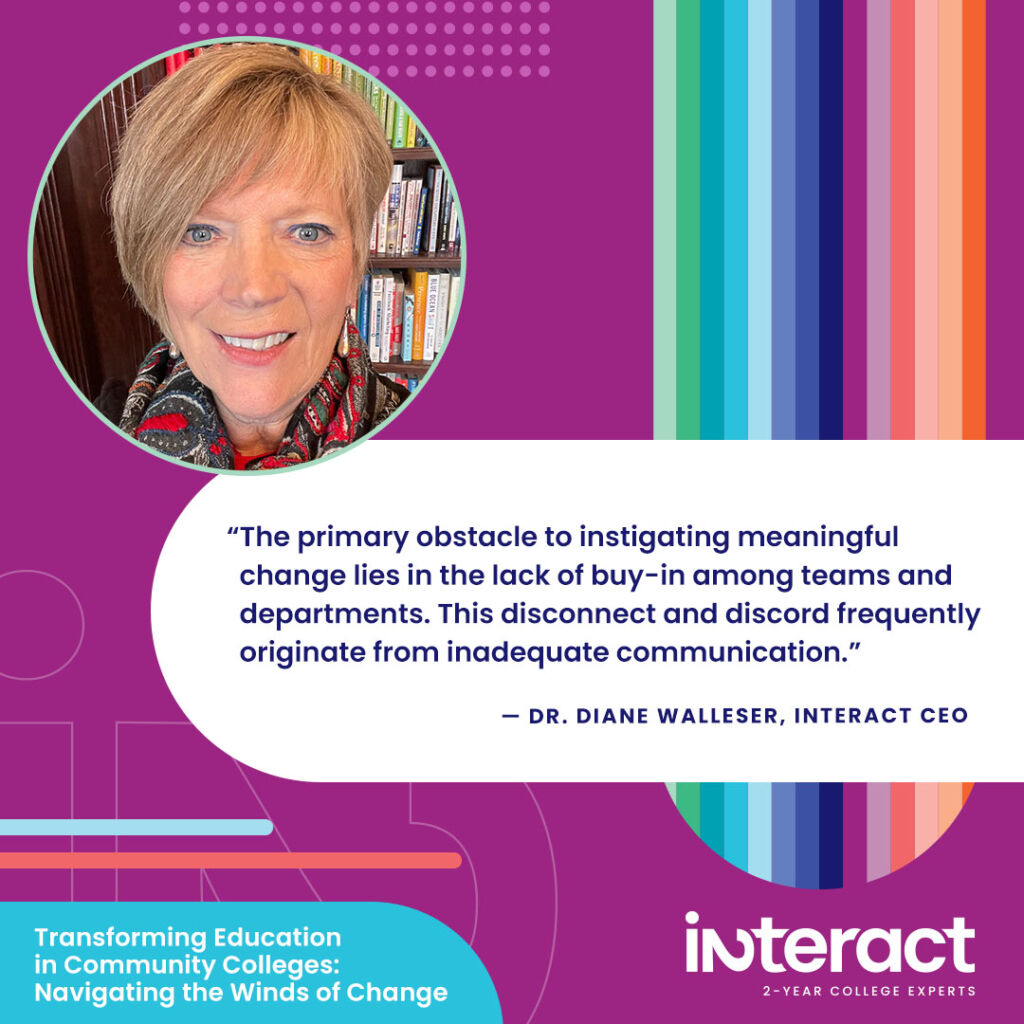
Communication is key. If stakeholders aren’t aligned, it can be hard to move forward — especially if there isn’t an established process to guide collaboration.
The first step is often compiling the data to define the real problem. Then, it’s time to get clear on key performance indicators and map out a process of change. But to go through the change management process, alignment and agreement are essential.
“So many times, college departments get stuck trying to work through conflict and differing opinions,” says Walleser. “But with the right change management approach, we can come up with a better solution collectively.”

To get everyone on board, it’s helpful if leadership has a robust collaboration process. We have worked with many colleges to help facilitate the change management process and build that essential alignment and agreement. But how can you create better collaboration if your college experiences a change in leadership?
What if You Have a New President? How to Get Leadership on the Same Page in Transforming Education
When a new president or VP joins the college, it can create a lot of waves. The most important thing is ensuring everyone has the same vision. That way, leadership and staff aren’t working at cross purposes.
“Part of the process is helping presidents assess the college’s current environment to refocus goals in a meaningful way,” says Walleser.
For example, one of our partnering colleges had a new president who wasn’t seeing eye-to-eye yet with all their departments. We started by collecting data in a pain point and opportunity scan, allowing staff from across teams to voice their concerns. Then, we looked for themes in the feedback and found the underlying patterns.
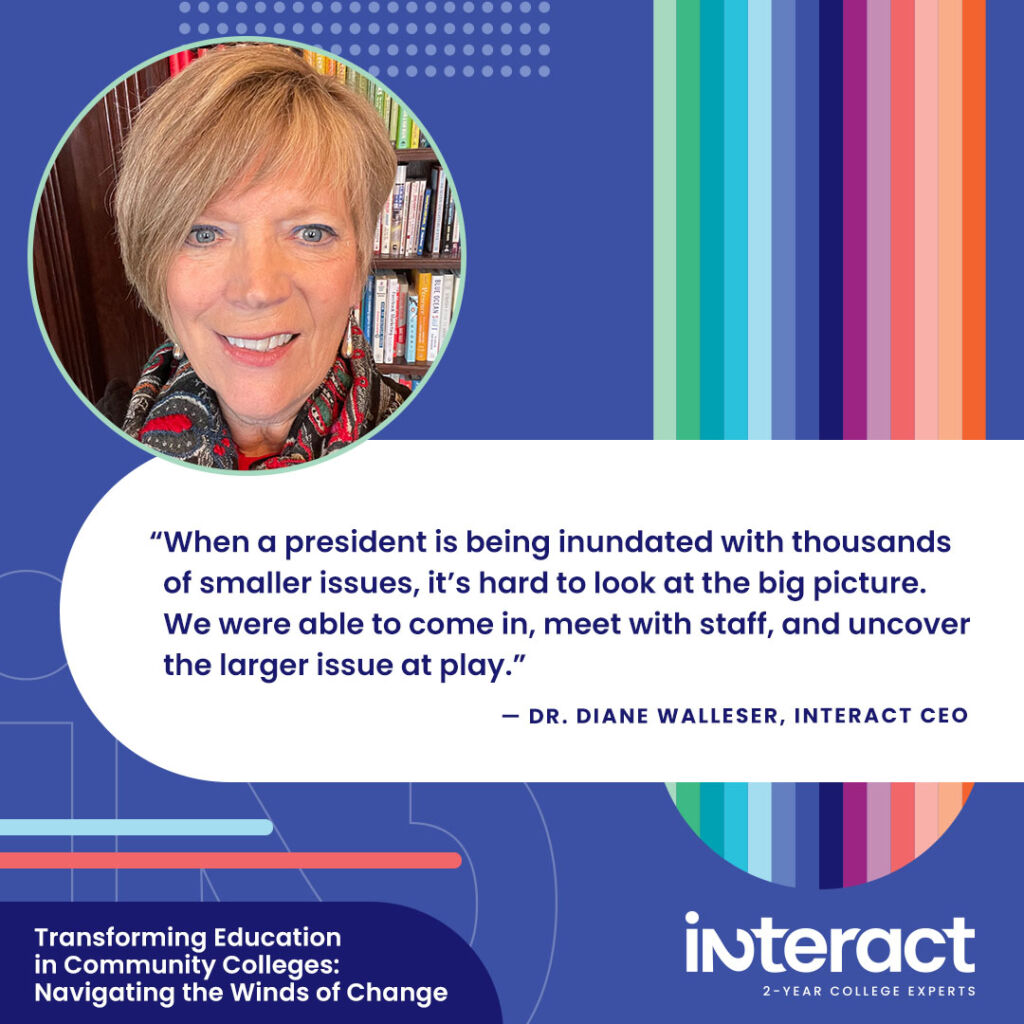
“It gave the president an opportunity to focus on the real problem so that they could tell their departments, ‘I heard what you said, and here’s what we’re going to do about it,’” says Walleser. “When a president is being inundated with thousands of smaller issues, it’s hard to look at the big picture. We were able to come in, meet with staff, and uncover the larger issue at play.”
Whether it’s a new president or VP, managing change well ensures everybody is on the same page. And that takes gathering data, having good communication, and making a solid plan. Transforming education effectively is a group effort.
“In our pain point and opportunity scan, we gather input across the college and then share it back to the entire group so everyone can clearly see where consensus is — and where the problems are,” says Walleser. “Otherwise, we all disagree on what to work on and have conflicting priorities.”
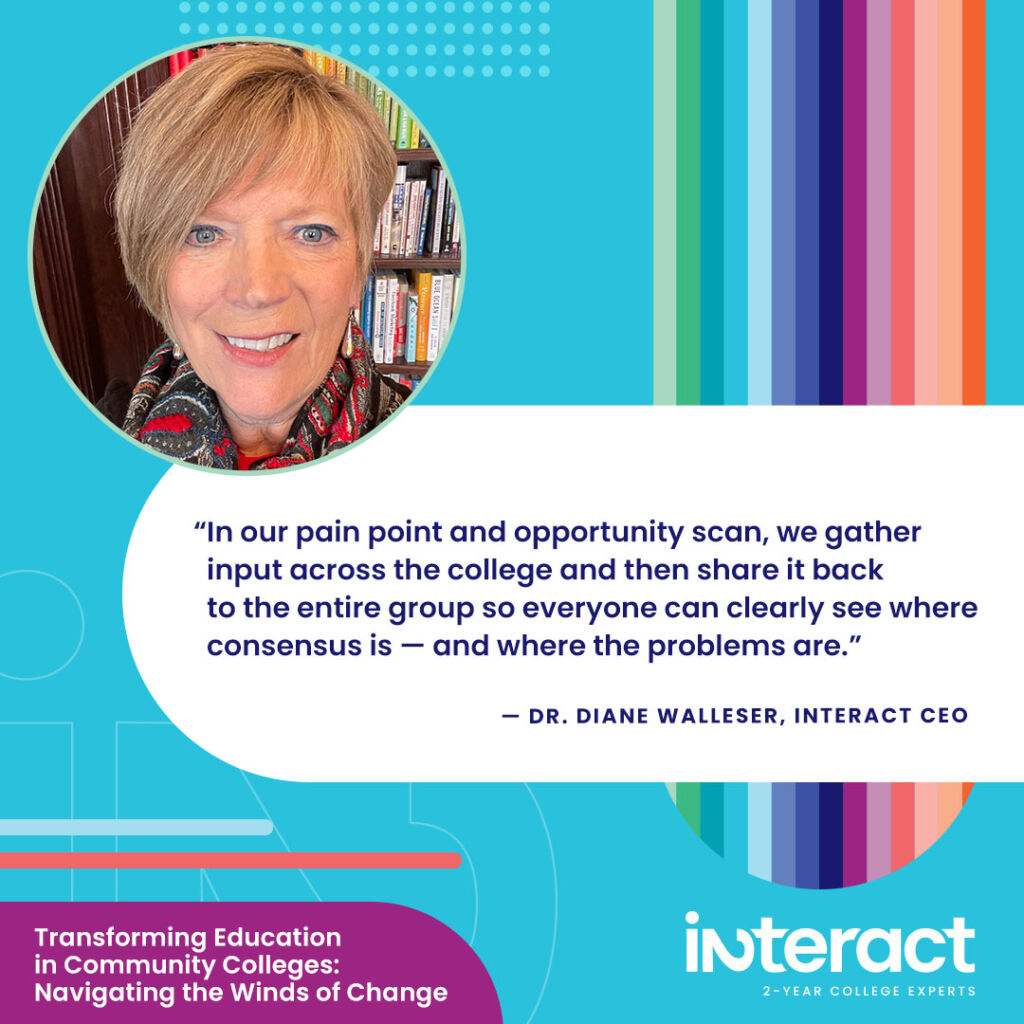
Overcoming Inertia: Awakening Strategic Momentum in Transforming Education
With the major shifts in college student demographics and leadership changes, Walleser says one thing always stands the test of time: a good strategic plan with measurable outcomes.
Even if your institution has new leadership, no one will throw away strategies that are working and generating results. Sometimes, the problem is overcoming inertia and stuck attitudes.
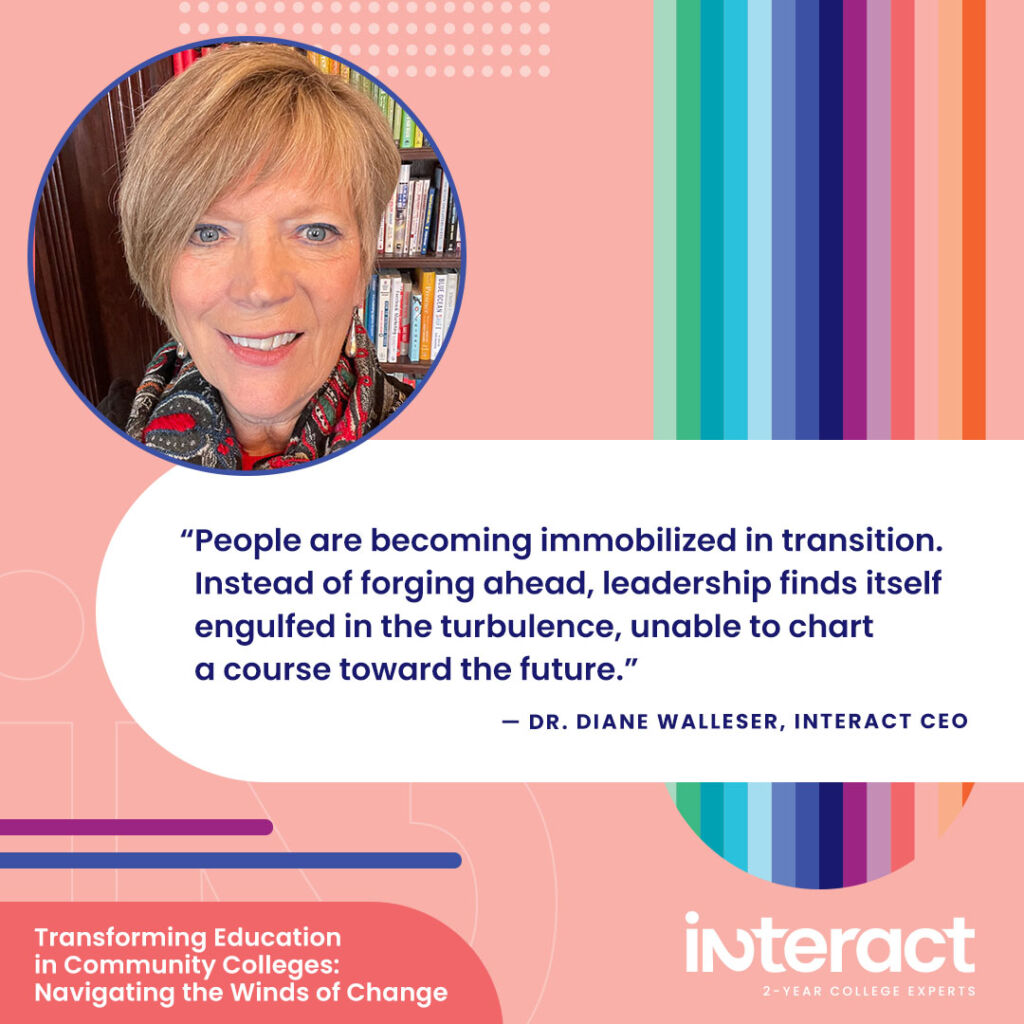
“People are becoming immobilized in transition,” remarks Walleser. “Instead of forging ahead, leadership finds itself engulfed in the turbulence, unable to chart a course toward the future.”
What are the main issues that keep our community colleges from transforming education?
- First, two-year institutions have limited resources and technology restrictions.
- We’re also up against changing student needs.
- Plus, there is no longer a one-size-fits-all-students solution. Colleges serve many different audiences with diverse challenges.
“Student need is intensifying, and they require more distinct supports,” says Walleser. “The old model built around serving traditional-aged 18-year-old students no longer works for most learners.”
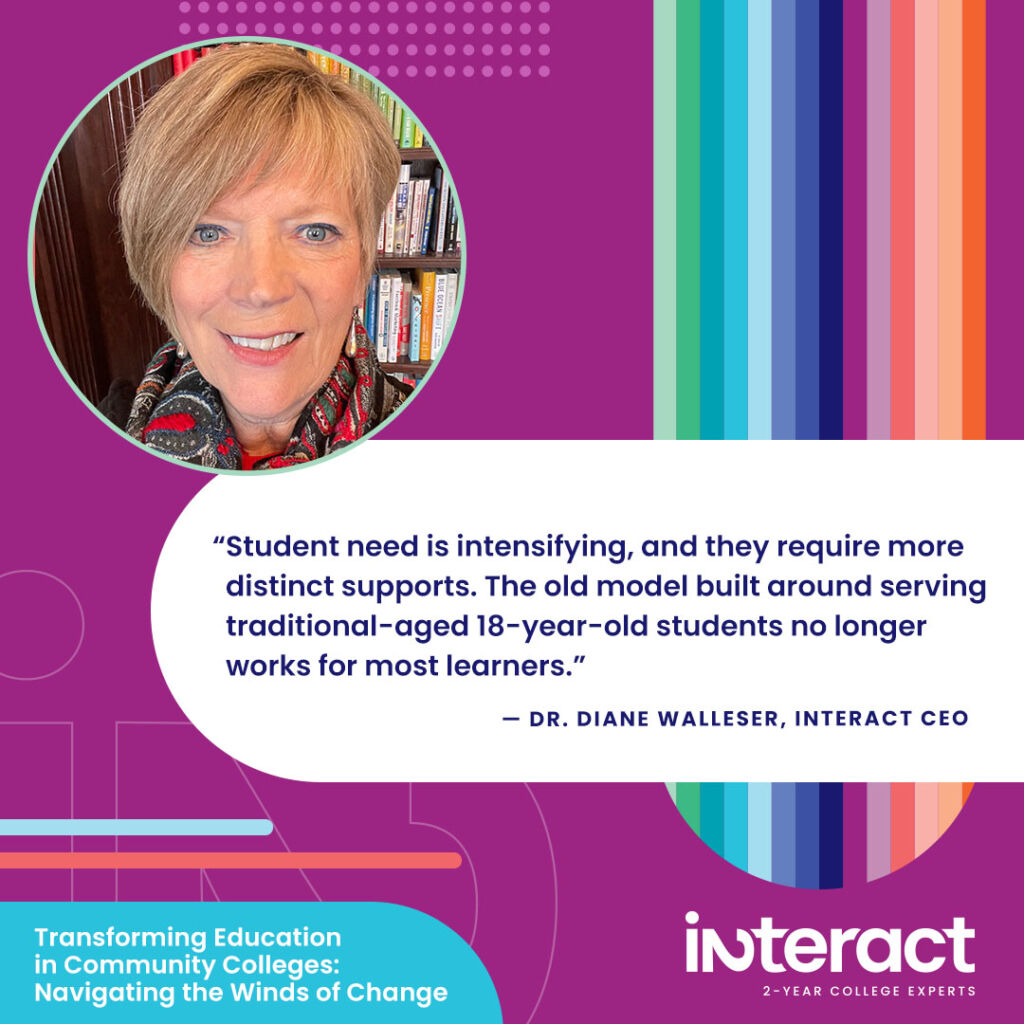
Most community college systems need more flexibility to accommodate so many different needs. It’s a daunting challenge that many of our partners face. But with any challenge comes hidden resiliency and innovative solutions. The first step is focusing on finessing your onboarding processes to boost enrollment.
Fighting Onboarding Overwhelm: Finding Focus Is Key for Transforming Education
Onboarding problems can seem overwhelming at first. As Walleser says, “You can come up with a million things that could be fixed.”
But where should you begin? According to our CEO, the trick is to inventory all the issues and then prioritize them, fixing one piece at a time. Keep in mind,though, that true transformation is a process and not a one-and-done event. And real change takes into account all the diverse needs of your student populations.

“There’s this mentality that if we just do this one big thing, then we’ll fix all our problems for everyone,” says Walleser. “But the truth is, you’ll get the most traction and ROI by breaking down problems by particular audiences instead of slapping on one general solution.”
For example, you could examine how well Hispanic students succeed compared to the rest of their cohort. Or, you could look at business pathway students versus health pathway students. Remember, a solution for one audience segment may not work for others.
“If you look at all of your programs at once, it’s too hard to properly diagnose underlying problems because each pathway may have different issues,” says Walleser.
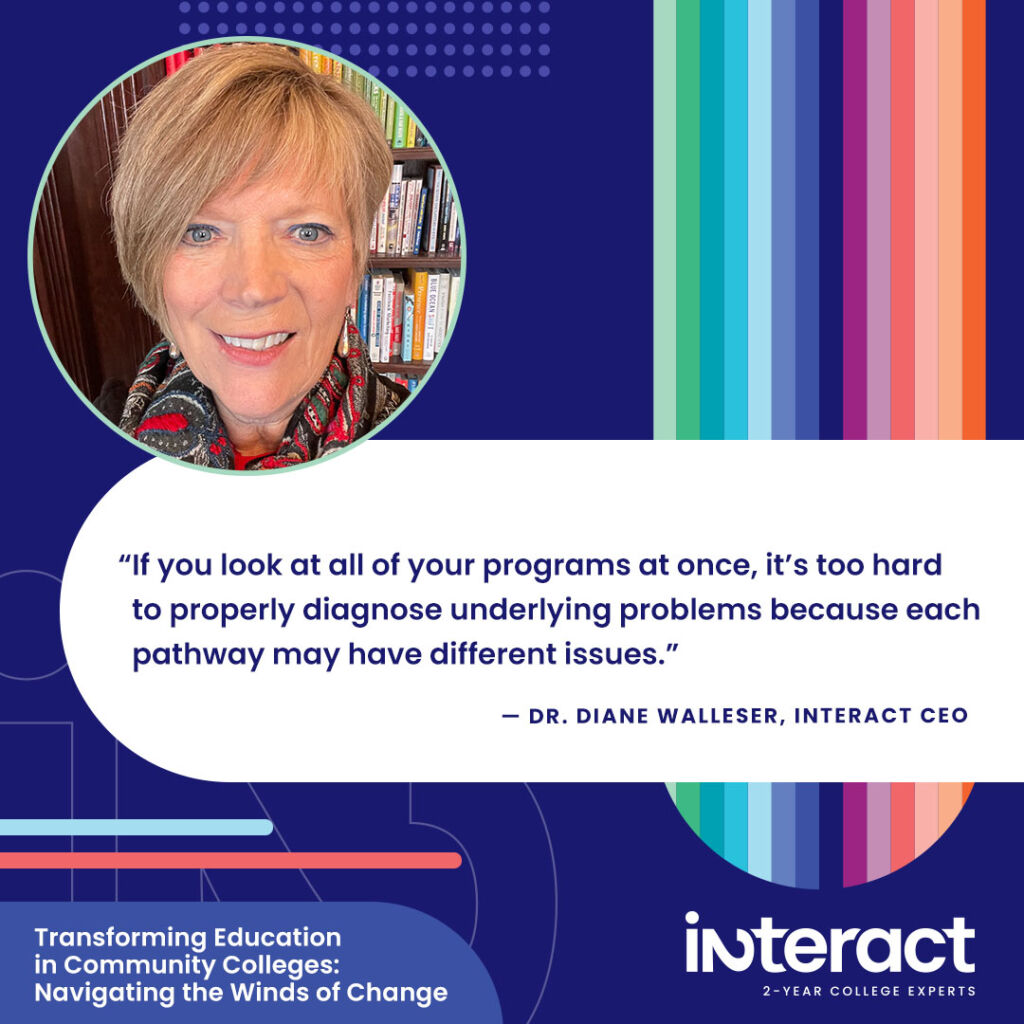
When it comes to prioritizing enrollment challenges, our CEO counsels promoting full-time enrollment first.
Full-Time Students Are the First Priority
“One of the biggest trends I see now with our colleges is that their full-time enrolled students are dropping,” says Walleser.
This is a concerning trend for two reasons. First of all, full-time students have better retention rates.
“If your ultimate goal is to retain students and get them to completion, then you have to incentivize full-time enrollment,” says Walleser. “Part-time students take much longer to complete and have lower success rates.”
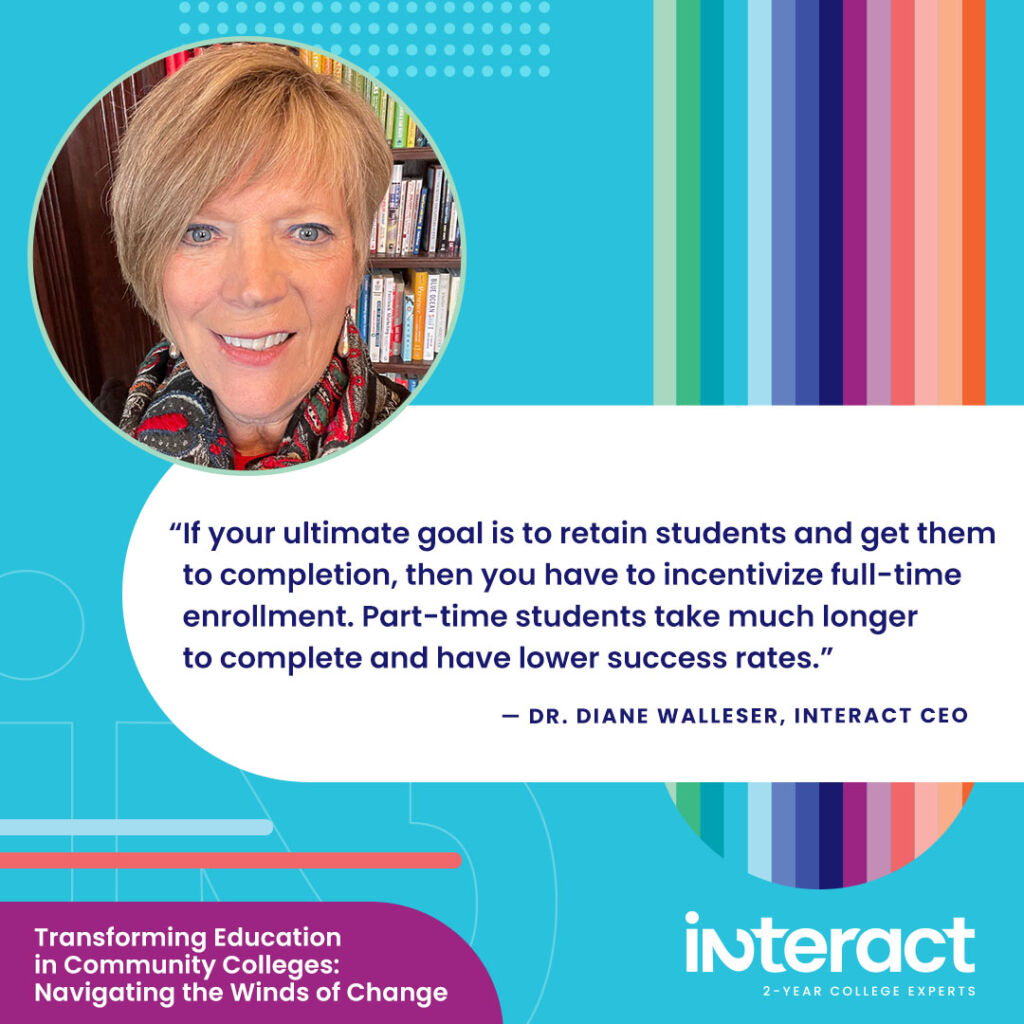
Additionally, if you grow your enrollment from part-time students, you only build one credit at a time. Full-time students can help you get to your enrollment goals more quickly. Yet, when colleges already struggle to attract and retain students, how can we encourage full-time enrollment?
“First of all, we must understand why students are not attending full time,” says Walleser. Is it because learners can’t put together a schedule? What if you offered more flexible scheduling and even block scheduling? Asking questions like these are crucial to transforming education.
Try to understand what flexible programming and support services your college can offer to help students manage their obligations. Walleser says, “Rather than blaming the problem on the students and saying we can’t fix them, we have to fix our support systems for students.”
Finally, make sure your communications reflect the value you offer. Most colleges forget to reinforce the message that students can improve their earning potential and live their best lives by earning a degree or certificate.
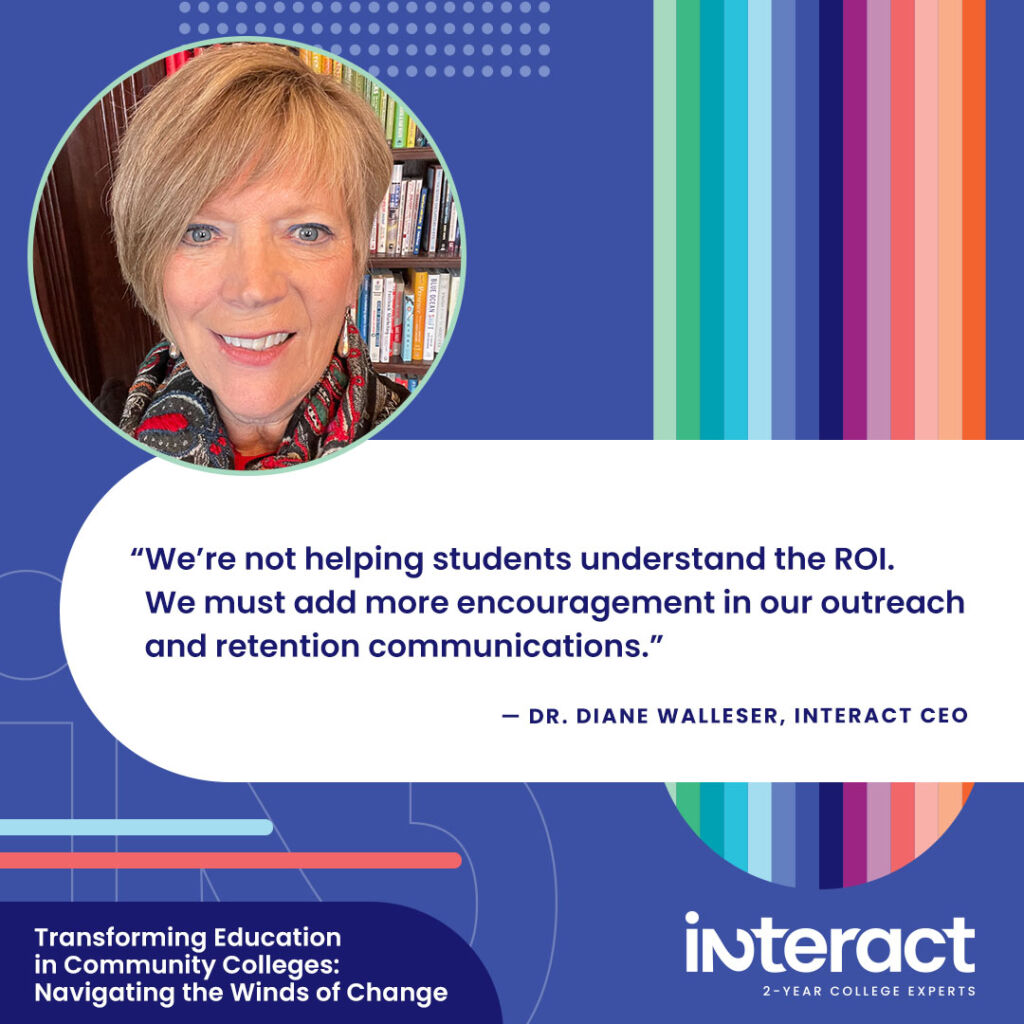
“We’re not helping students understand the ROI,” says Walleser. “We must add more encouragement in our outreach and retention communications.”
The Bottom Line for Transforming Education: Seeing the Big Picture
Change is a process. If managed well, it can be mapped out from start to finish to help meet your goals.
“The processes we go through with our college partners help senior leaders understand the perceptions of their community college,” says Walleser. “It reveals the bigger issues holding them back from the work they need to do.”
At Interact, we aim to remove the overwhelm from change so your team can move forward together.
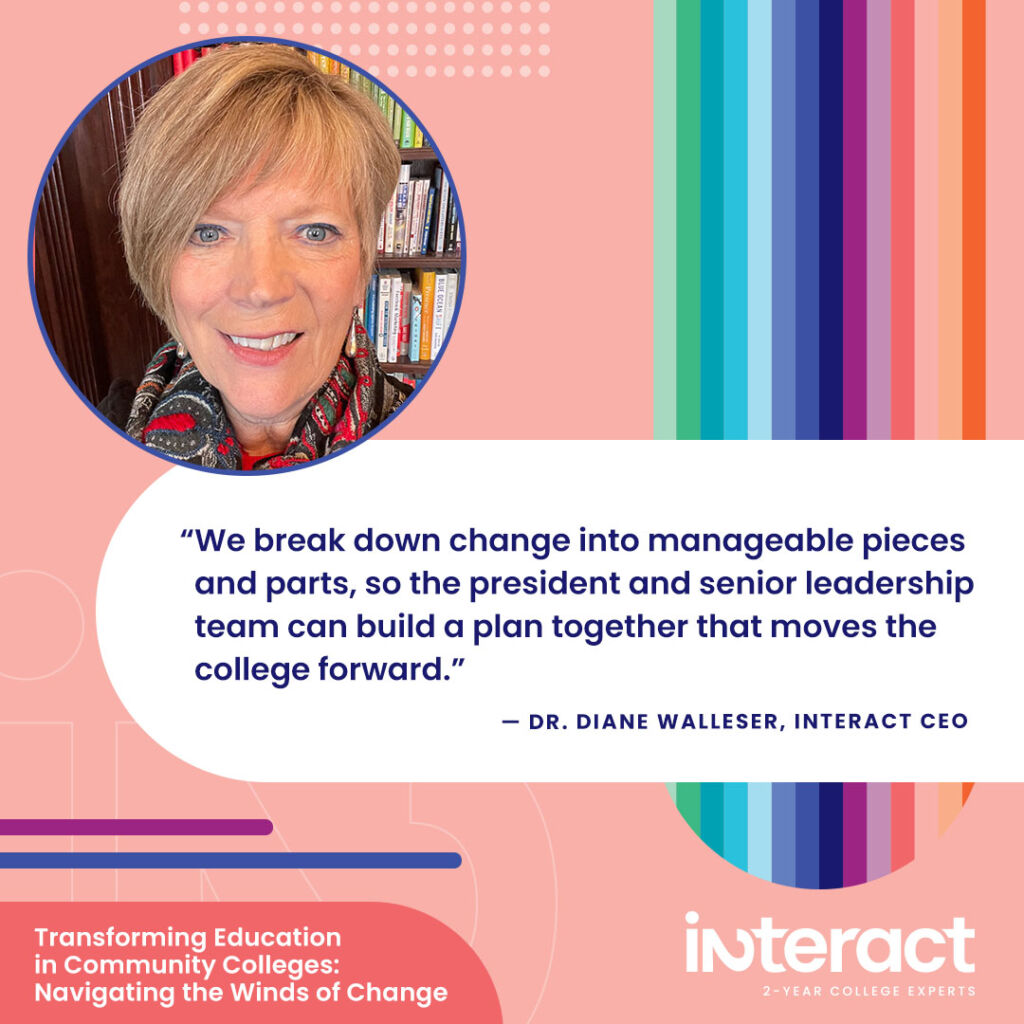
As Walleser says, “We break down change into manageable pieces and parts, so the president and senior leadership team can build a plan together that moves the college forward.”
Is your college ready for a change but not sure where to start? Don’t get bogged down by indecision and confusion. Now is the time to take charge of your enrollment. We’ve helped colleges like KCC gain +12% enrollment, even in the middle of a national downturn.
Schedule a free consultation and find out how to make our clients’ successes yours!
Keep reading:





